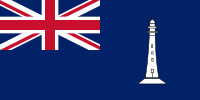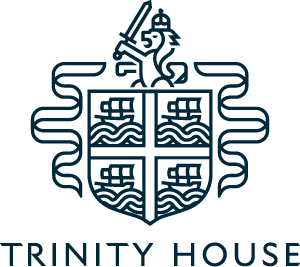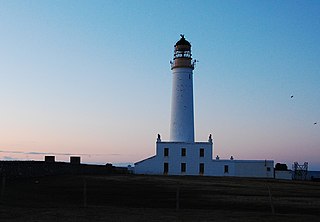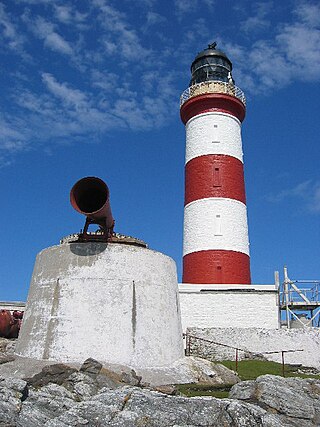

The Northern Lighthouse Board (NLB) is the general lighthouse authority for Scotland and the Isle of Man. It is a non-departmental public body responsible for marine navigation aids around coastal areas.


The Northern Lighthouse Board (NLB) is the general lighthouse authority for Scotland and the Isle of Man. It is a non-departmental public body responsible for marine navigation aids around coastal areas.
The NLB was formed by Act of Parliament in 1786 as the Commissioners of Northern Light Houses, largely at the urging of the lawyer and politician George Dempster ("Honest George"), to oversee the construction and operation of four Scottish lighthouses: Kinnaird Head, North Ronaldsay, Scalpay and Mull of Kintyre, for which they were empowered to borrow up to £1,200. Until then, the only major lighthouse in Scotland was the coal brazier mounted on the Isle of May in the Firth of Forth, together with some smaller lights in the Firths of the Tay and Clyde. None of the major passages around Scotland, which led through dangerous narrows, were marked.
The commissioners, whose first president was the Lord Provost of Edinburgh, Sir James Hunter-Blair, advertised for building estimates, but there were no takers. They received an offer of help from Ezekiel Walker of King's Lynn, who had developed a parabolic reflector for the Hunstanton Lighthouse, [1] and sent Thomas Smith, who was making his name in street lighting in Edinburgh and had offered help, to England to learn from him. Smith soon returned and instructed an Edinburgh architect to prepare the plans for four lighthouses.
The £1,200 was spent before the first light at Kinnaird Head was finished, and a further Act of Parliament was required which allowed them to receive half their dues[ clarification needed ] before all the lights were finished. By the end of 1787 the first light had been installed. At the Mull of Kintyre everything had to be transported by pack horse from Campbeltown, 12 miles away, but it was lit by October 1788. To get to Scalpay in the Outer Hebrides and North Ronaldsay in the Orkney Isles needed boat trips across rough waters for Smith and Mills, the stonemason, but all the same the job was completed by October 1789, to widespread praise. The dues which had originally been set at two shillings per ton of cargo in the 17th century, were now reduced to one penny per ton. [2]
The Commissioners' most famous engineer was Robert Stevenson, whose sons David, Alan, and Thomas followed their father into the profession. The Stevenson dynasty built the majority of the Northern lights, in some exceptionally challenging locations. Their lights were some of the engineering masterpieces of their time, notably those at Bell Rock, Skerryvore, and Muckle Flugga.

Between 1876 and 2005 the NLB also maintained foghorns at a number of locations. The last (at Skerryvore) was sounded for the last time on 4 October 2005. [3]
The board is based at its Georgian headquarters building in George Street in the centre of Edinburgh, from where it remotely monitors its network. Technical operations are carried out from a base in Oban, Argyll and Bute, where there are maintenance workshops and facilities for the construction of buoys and beacons. The NLB's vessels are also based here. The Oban depot has been recently modernised.[ when? ]
Under the terms of the Scotland Act 1998, the NLB is not a devolved body and thus remains directly accountable to the UK Secretary of State for Transport. In practice, there is close co-operation with both the Scottish Government and the Isle of Man Government. The NLB is funded by pooled light dues administered by the UK's Department for Transport, and distributed to the NLB, Trinity House, and the Commissioners of Irish Lights.

As of 31 March 2019, the NLB operates the following: [4]
The NLB operates two lighthouse tenders, known by the prefix Northern Lighthouse Vessel, or NLV. NLV Pole Star has been in service since 2000 and NLV Pharos was delivered on 31 March 2007 to the Oban depot. [5] This is the tenth Pharos, replacing the ninth Pharos which was sold in September 2006 for use as a Fishery Protection vessel for South Georgia and the South Sandwich Islands.

Most of the commissioners have always been ex officio appointments. The original commissioners appointed in 1786 were the Scottish law agents of the Crown, the sheriffs of Scotland's coastal counties, and the provosts and lord provosts of Scottish cities and towns with strong mercantile interests. Reform of local government and sheriffdoms have since resulted in changes. Previous commissioners include Richard Vary Campbell. [6]
The current Commissioners of Northern Lighthouses, as provided by Schedule 8 to the Merchant Shipping Act 1995, are the Lord Advocate and the Solicitor General for Scotland; the lords provost of Edinburgh, Glasgow, and Aberdeen, the conveners of the Highland Council and the Argyll and Bute Council; the sheriffs principal of all the sheriffdoms in Scotland; a Manx representative nominated by the Lieutenant Governor of the Isle of Man and appointed by the Secretary of State; and up to five co-opted commissioners. [7]

The NLB uses two flags, an ensign and a Commissioners' Flag. The ensign is a Blue Ensign defaced with a white lighthouse in the fly, and is for general use. The Commissioners' flag, a plain White Ensign with a pre-1801 Union Flag in the canton, defaced with a blue lighthouse in the fly, is the only British flag still in use which incorporates the pre-1801 Union Flag. [8] This flag is only flown from vessels with Commissioners aboard.
The Board HQ flies the Commissioners' flag, alongside the Saltire and the Isle of Man flag. [9]

The Corporation of Trinity House of Deptford Strond, also known as Trinity House, is the official authority for lighthouses in England, Wales, the Channel Islands and Gibraltar. Trinity House is also responsible for the provision and maintenance of other navigational aids, such as lightvessels, buoys, and maritime radio/satellite communication systems. It is also an official deep sea pilotage authority, providing expert navigators for ships trading in Northern European waters.

North Ronaldsay is the northernmost island in the Orkney archipelago of Scotland. With an area of 690 hectares (2.7 sq mi), it is the fourteenth-largest. It is mentioned in the Orkneyinga saga; in modern times it is known for its historic lighthouse, migratory bird life and unusual breed of sheep.

Auskerry is a small island in eastern Orkney, Scotland. It lies in the North Sea south of Stronsay and has a lighthouse, completed in 1866.

Thomas Smith was a Scottish businessman and early lighthouse engineer. He was appointed as the first Chief Engineer to the Northern Lighthouse Board in 1786.
The Commissioners of Irish Lights, often shortened to Irish Lights or CIL, is the body that serves as the general lighthouse authority for Northern Ireland and the Republic of Ireland and their adjacent seas and islands. As the lighthouse authority for the island of Ireland it oversees the coastal lights and navigation marks provided by the local lighthouse authorities, the county councils and port authorities.
Skerryvore is a remote island that lies off the west coast of Scotland, 11 nautical miles southwest of Tiree. Skerryvore Lighthouse is located on these rocks, built with some difficulty between 1838 and 1844 by Alan Stevenson.

The Tarbat Ness Lighthouse is located at the North West tip of the Tarbat Ness peninsula near the fishing village of Portmahomack on the east coast of Scotland. It was built in 1830 by Robert Stevenson and has an elevation of 53 metres (174 ft) and 203 steps to the top of the tower.
Dennis Head Old Beacon is a ruined lighthouse on the island of North Ronaldsay, Orkney, Scotland. The beacon and keepers' houses are protected as a scheduled monument.

Covesea Skerries Lighthouse, originally belonging to the Northern Lighthouse Board (NLB), is built on top of a small headland on the south coast of the Moray Firth at Covesea, near Lossiemouth, Moray, Scotland.

NLV Pole Star is a lighthouse tender operated by the Northern Lighthouse Board (NLB), the body responsible for the operation of lighthouses and marine navigation aids around the coasts of Scotland and the Isle of Man.
A general lighthouse authority (GLA) is one of three agencies primarily responsible for aids to navigation in the United Kingdom and the Republic of Ireland. They are divided into regions as follows:

NLV Pharos is a lighthouse tender operated by the Northern Lighthouse Board (NLB), the body responsible for the operation of lighthouses and marine navigation aids around the coasts of Scotland and the Isle of Man.
Light dues are the charges levied on ships for the maintenance of lighthouses and other aids to navigation.

Eilean Glas Lighthouse is situated on the east coast of the island of Scalpay in the Outer Hebrides of Scotland. It was one of the original four lights commissioned by the Commissioners of the Northern Lights, and the first in the Hebrides. These lighthouses were built by Thomas Smith.
Three lighthouses can be found around the shores of the Isle of Arran in the Firth of Clyde. One is located on the island of Pladda in the south and the other two can be found on Holy Island in Lamlash Bay to the east of Arran. All three are still in service and maintained by the Northern Lighthouse Board. They are now fully automatic since the electrification of both lighthouses on Holy Isle in 1977.
Events from the year 1786 in Scotland.

The Mull of Kintyre Lighthouse on Mull of Kintyre was the second lighthouse commissioned in Scotland by the Commissioners of the Northern Lights. It was designed and built by Thomas Smith and completed in 1788. Smith had previously designed the light at Kinnaird Head, but Mull of Kintyre was a far more substantial project, in a far more remote location.

Granton Lighthouse is a former depot on West Harbour Road in Granton, Edinburgh, Scotland, now used as business accommodation. Originally known as the Northern Lighthouse Board Engineering, Storage and Testing Facility, it was formerly used by the Northern Lighthouse Board to store and distribute supplies, test and service equipment, and train employees.